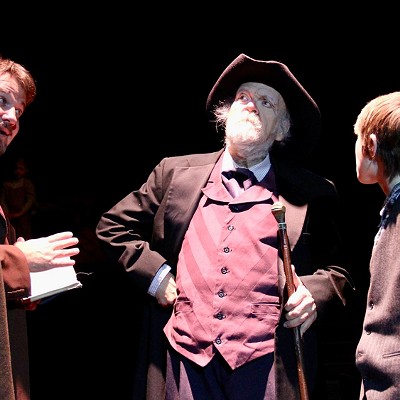The rail line, extending east of Santa Fe Station, which is slated to be the city’s future intermodal transportation hub, to the east bank of the Oklahoma River, is under a 30-year lease-to-own agreement between the rail company and the state’s transportation department.
The state originally acquired the line from the now-defunct Rock Island and Pacific Railroad company, and now the final payment by Union Pacific to take over ownership of the line is scheduled to be made at the end of November.
Rail advocates and area transit officials have stressed the line’s importance because in the commuter rail plan it provides the link between the Adventure District line (which extends into northeastern Oklahoma City near Remington Park), the line running to Midwest City and Tinker Air Force Base and the future intermodal transportation hub, where commuters will be dropped off or connected to different lines.
right, Railroad tracks east of downtown OKC curve northward toward an intersection with north/south tracks.
A study earlier this year named Santa Fe Station as the best location for an intermodal hub, which would connect several different modes of transportation, including some that have not yet been built, such as the MAPS 3 modern streetcar, commuter rail to Edmond, Norman, Moore, Midwest City and Will Rogers World Airport, and a possible high-speed rail system from Tulsa and Dallas.
Marion Hutchison, president of the nonprofit rail advocacy group OnTrac, said the group hopes that the city begins negotiations soon with Union Pacific to work out an agreement that would allow the right of way to be used for commuter rail before the company decides to do something with the little-used line or tear it down.
“The loss of this corridor — never being able to use that for a commuter rail corridor — that’s worse than losing Union Station,” Hutchinson said, referring to the former rail station that was being considered as the future intermodal hub location, but fell out of favor because it interfered with the Interstate 40 Crosstown Expressway.
Hutchison said a good portion of the line is rarely used by Union Pacific, although other parts further east have some regular traffic, and the line provides the only rail bridge on the eastern part of the Oklahoma River.
Bob Kemper, board member of nonprofit group Oklahoma Alliance for Public Transportation, said he has been part of an ongoing conversation with Union Pacific for a few years now, and that while nothing is final, it may be possible to purchase part of the right of way that Union Pacific does not use and has no plans for, although it may be harder to obtain rights to the bridge.
Rick Cain, administrator for the Central Oklahoma Transportation and Parking Authority and director of public transportation and parking for OKC, said the transfer of ownership from the transportation department to Union Pacific may make acquiring rights for commuter rail on the right of way more difficult.
Thus far, the city has not spoken with Union Pacific about working out a deal, Cain said, and that may not occur until the Association of Central Oklahoma Governments study for the commuter rail — known as an alternatives analysis study — has been completed.
Once completed, the study will allow planners to see potential com-plications
in the system and hopefully set up a framework to begin bringing in
money from the federal government and local municipalities participating
in the system, Cain said.
“If
we’re going to want to do anything in the future, we’re going to have
to work with Union Pacific to get access to that, whether we purchase it
or whether we lease or whatever we do,” he said. “It’s one of those
things that before you start spending money to solve the problem, you’ve
got to have money. That’s going to be the challenge: Where does that
money come from to be able to do this?” Cain also said Union Pacific is
not running trains through a large part of the property, but an earlier
episode showed just how complicated using rail lines can be.
During
the state’s centennial celebration, COTPA wanted to bring a passenger
car from the Adventure District line — which it owns — into Bricktown
using a line then owned by the state Department of Transportation and
leased by Union Pacific, Cain said.
The plan quickly ran into problems, he said.
“There’s
some significant issues and it would have necessitated spending in
excess of a couple of million dollars to make it come together, and
that’s why it didn’t really happen,” Cain said. “As a general rule, the
freight carriers don’t like to have passenger rail on their freight
lines, and there’s a small section of track that’s currently active by
Union Pacific. It became obvious pretty quickly that wasn’t going to
happen.”
The
line that will soon be Union Pacific’s does play an important role in
bringing the commuter rail line from the hub to Midwest City and Tinker
Air Force Base, Cain said, as well as connecting the Adventure District
line to the hub.
“It
is important only from the standpoint that it (is) where we would be
making the connection if we’re coming in from either the Tinker/Midwest
City area or … (the Adventure District line),” Cain said. “It’s critical
to make that connection. That is the way it will be done.
“There’s
a lot of interest to be able to make that connection, but it’s going to
take an awful lot of planning. And how do we pay for it?”
Photo by Mark Hancock











